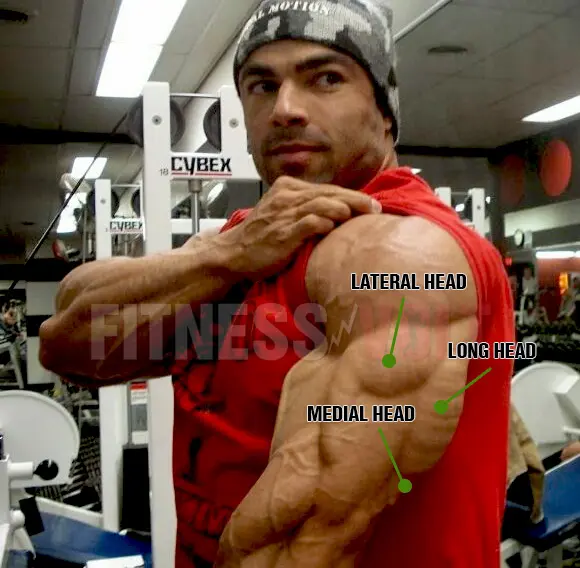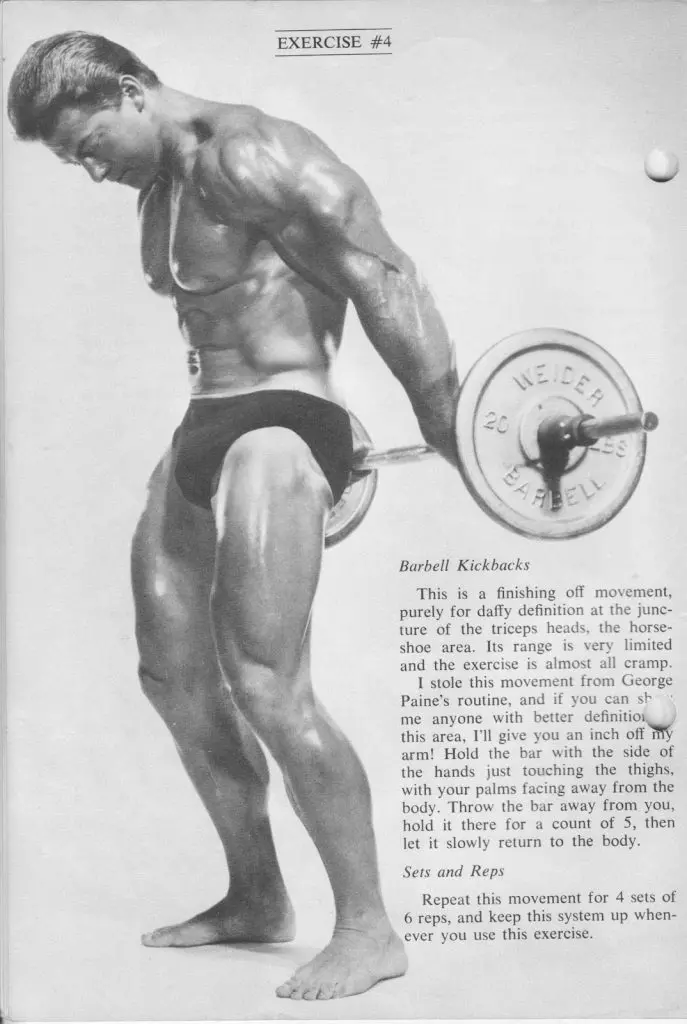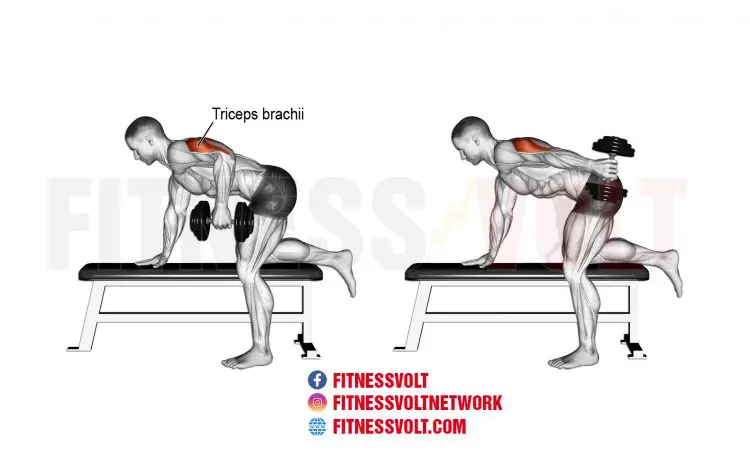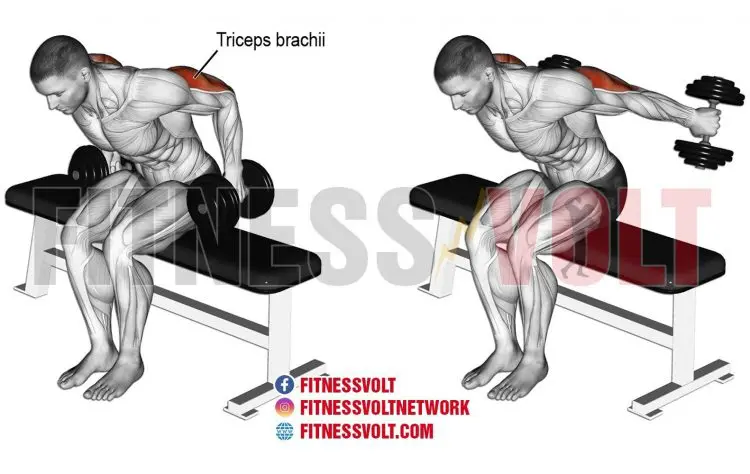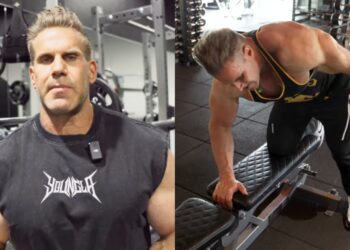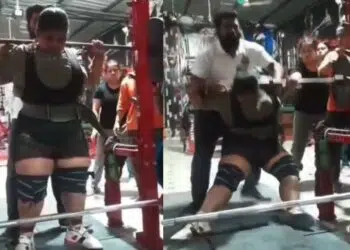Your triceps are an important muscle. The biceps are arguably more well-known, but it’s the triceps that make up the majority of your upper arm size. Your triceps are involved in every compound pressing exercise you do. Still, if you are serious about sculpting your best arms ever, you need to include some direct triceps exercises in your bodybuilding program.
For a lot of lifters, that means variations of triceps pushdowns and skull crushers. These exercises are largely regarded as the best movements for building bigger triceps. Some enlightened lifters also include overhead triceps extensions in their workouts to train their tris from an additional joint angle.
However, an exercise you WON’T see so often is triceps kickbacks. A lot of lifters view kickbacks as ineffective. That’s probably because, done correctly, you won’t be able to use much weight. Triceps kickbacks are a very strict isolation exercise.
Don’t let this put you off; despite the fact you won’t be lifting hefty weights, triceps kickbacks are still an effective exercise. Bodybuilders bigger and stronger than you have used this exercise to great effect!
One of the lesser-known kickback variations is performed using a barbell. This old-school arm exercise could be just what you need to kick your triceps growth up a level. In this article, we reveal how to do this unusual movement and provide you with a few alternatives you can use instead.
Barbell Kickbacks Anatomy
Level Up Your Fitness: Join our 💪 strong community in Fitness Volt Newsletter. Get daily inspiration, expert-backed workouts, nutrition tips, the latest in strength sports, and the support you need to reach your goals. Subscribe for free!
Barbell kickbacks are an isolation exercise that targets your triceps brachii, or triceps for short. Your triceps have three distinct origins that come together at a common insertion point just below your elbow. This is what gives the triceps their name (tri = three) and their unique horseshoe shape.
Doing kickbacks with a barbell works all three heads of the triceps but emphasizes the long head. That’s because when you do triceps kickbacks, as well as extending your elbows, you also need to extend your shoulders. This increases triceps long head activation. As an added bonus, barbell triceps kickbacks also work your posterior deltoids, which is also a shoulder extender.
How to Do Barbell Kickbacks
There are two ways to do barbell kickbacks – standing and bent over. The standing version involves more shoulder than elbow movement, meaning it mainly works the long head of your triceps. The bent-over version combines shoulder extension with elbow extension, making it a more complete triceps exercise.
You’ll also be able to move through a larger range of movement with this variation. Try them both to see which one you prefer.
How to do standing barbell kickbacks:
- Hold a barbell behind your back using a shoulder-width grip and your palms facing away from you. Pull your shoulders down and back. Lean forward very slightly.
- Keeping your arms straight, lift the barbell away from your body as far as you can. Don’t worry; this is a small range of motion.
- Lower the barbell back to your legs/butt and repeat.
How to do bent-over barbell kickbacks
- Hold a barbell behind your back using a shoulder-width grip with palms facing away from you. Pull your shoulders down and back. Lean forward until your upper body is roughly parallel to the floor. Try not to round your lower back.
- Starting with your arms bent to around 90-degrees, extend your arms and push the barbell out and behind you. Keep your upper arms close to your sides.
- Bend your arms, lower the bar back to your legs, and repeat.
Because you won’t be able to go heavy with either of these variations, barbell triceps kickbacks are best used as a finisher at the end of your main triceps workout. Use light to moderate weights and medium to high reps.
Focus on tensing your triceps as hard as possible and chasing a pump. If you use heavy weights, you’ll probably just end up cheating, making this old-school triceps exercise much less effective. This exercise also works well when combined with blood flow restriction training.
Barbell Kickbacks Advantages and Benefits
What makes this such a good exercise? Good question! The main benefits and advantages of barbell kickbacks are:
Target the long head of your triceps – building the long head of your triceps will make the back of your upper arm thicker. It will also contribute to the horseshoe shape of your upper arm. Both versions of barbell kickbacks put a welcome emphasis on the long head of your triceps.
Less elbow stress – because you can’t use such heavy weights for barbell kickbacks, a lot of lifters find that they are more joint-friendly than things like skull crushers and overhead triceps extensions. Use this exercise to build your triceps, even if you have a history of elbow pain.
Variety – the best way to train your triceps is from a range of different angles. That means you need to do exercises with your upper arms close to your sides, perpendicular to your body and extended overhead. Both variations of barbell kickbacks mean you can train your triceps in a new position using an unusual exercise, which may help produce renewed muscle growth.
Accessible – cable pushdowns are arguably the most popular triceps exercise. But, if you train at home or in a garage gym, you may not be able to do this classic triceps builder. Needing nothing more than a barbell, this exercise is a useful low-tech alternative to cable machine triceps exercises.
Barbell Kickback Alternatives
Both variations of the barbell kickback are useful triceps exercises that you can use to add variety to your arm workouts. That said, like any exercise, they’ll lose some of their potency if you do either of these moves too often. Keep your workouts fresh and productive with these barbell kickback alternatives.
Level Up Your Fitness: Join our 💪 strong community in Fitness Volt Newsletter. Get daily inspiration, expert-backed workouts, nutrition tips, the latest in strength sports, and the support you need to reach your goals. Subscribe for free!
1. Dumbbell kickback
The standard dumbbell kickback is a useful exercise because it allows you to train one arm at a time, identifying and fixing any left-to-right strength imbalances. Like the bent-over barbell kickback, this move involves elbow AND shoulder extension, so it really hits the long head of your triceps.
The key to this exercise is keeping your upper arm stationary and close to your side. Use your triceps and not momentum to press the weight back.
Learn how to do dumbbell kickbacks here.
2. Seated dumbbell kickback
This exercise is very similar to the bent-over barbell version discussed earlier. The main advantage is that, by sitting on a bench, you are free to focus on working your arms and won’t have to use your legs as much. Take care not to round your lower back as you lean forward. You could also do this exercise using a barbell.
Check out our guide to seated dumbbell kickbacks here.
3. Cable kickbacks
The main disadvantage of doing kickbacks with free weights is that when your elbow is bent, there is very little tension on your triceps. That means you cannot use a large range of motion; 90-degrees is really all that’s practical.
With cable kickbacks, your muscles are under tension for much longer, which means this version may be more effective. However, you will need access to a low cable machine to do it, although you can also do it using a resistance band fixed to a low anchor point.
Learn how to do cable kickbacks here.
4. Two-handed cable kickbacks
With this cable kickback variation, you get to train both arms at the same time. There are several ways to do this exercise, depending on the equipment you have available. If you only have a single low pulley, use a rope handle. But, if you have dual low pulleys, you can use two handles and train your arms independently.
With both options, make sure you adhere to the tenets of kickbacks by keeping your upper arms stationary and tucked into your sides, ensuring that all of the movement comes from your elbows. You can also do this exercise using resistance bands.
5. Chest supported dumbbell kickbacks
This kickback variation takes your legs and upper back out of the equation, so you are free to focus on working your triceps to failure in relative comfort.
How to do it:
- Lie face-down on a flat or slightly inclined exercise bench. Hold a dumbbell in each hand. Pull your upper arms into your sides and keep them there for the duration of your set. Turn your hands, so your palms face inward.
- Extend your elbows and press the weights back and toward your legs. Squeeze your triceps at the mid-point of each rep.
- Bend your arms to 90-degrees and repeat.
Barbell Kickbacks – Wrapping Up
While heavy compound exercises like close-grip bench presses and dips can help you build bigger triceps, don’t underestimate the power of isolation exercises done with less weight. These moves allow you to target your triceps with laser-like precision and even emphasize individual triceps heads.
Barbell kickbacks are unusual, but that’s what makes them such a valuable addition to your training toolbox. Sometimes, the best way to develop a muscle is by hitting it with something it’s never done before.
Don’t dismiss kickbacks just because you can’t use big weights. Done strictly, they’re a very effective triceps builder and shaper. You will, however, have to check your ego for this one as lifting too much weight will make these exercises much less effective.
Interested in measuring your progress? Check out our strength standards for Bench Press, Close Grip Bench Press, Cable Kickback, and more.

